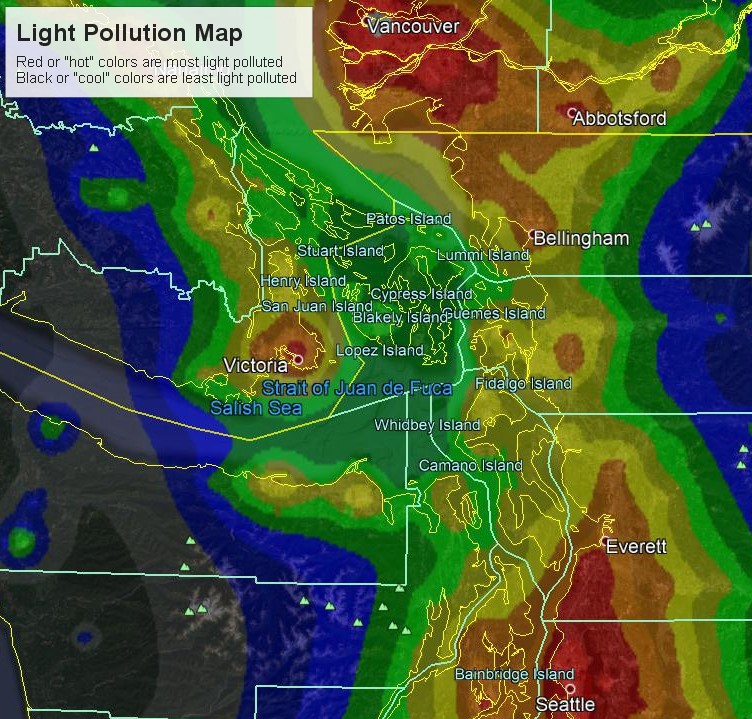
Credit: David Lorens (University of Wisconsin-Madison) overlaid on Google Earth
At the mention of land preservation, one’s mind often fixates on all things terrestrial: green forests, running streams, mountains, and wildlife. But does your attention ever focus upward, towards the stars? Not as likely—but in fact, preserving land from development also means that we are protecting our night skies from added light pollution.
Light pollution is an excess of man-made lighting that disrupts ecosystems, wastes energy, and deprives Earthlings of the ability to see the Milky Way or anything beyond our moon and the brightest stars. In North America, about 80 percent of the population lives in areas where our home galaxy is obscure.
Here in the San Juan Islands, we are fortunate to live under relatively dark skies (view the light pollution map to see how our islands compare with surrounding areas). Islands naturally have light-free buffer zones, as humans don’t typically build lighted structures on water. Like many diminishing resources, dark skies become more precious as locations for high-quality stargazing become scarcer. The fact that our islands possess access to a diminishing natural resource is even more cause for our community to actively conserve our views of the cosmos and encourage a reduction of light pollution.
Losing a sky full of stars isn’t just a detriment to human discovery and wonder, it adversely effects certain groups of plants, birds, insects, amphibians, mammals and reptiles. Plants and animals have evolved to depend on the daily light cycle to dictate their life-sustaining behaviors such as evading predators, feeding, reproducing, migrating, and sleeping. About half of all species on Earth start their waking activities at sundown. Altering their environment with artificial lighting is another form of habitat loss, and is yet another reason why land conservation is so important.
So, what can you do besides helping us preserve land by donating or volunteering? Start at home and take a look at your outdoor lighting. According to the International Dark Skies Association (IDA), about 30 percent of all outdoor lighting in the U.S. is wasted. If you are a homeowner, you can ensure that you are minimizing your contribution to light pollution by mounting your outdoor lighting as low as possible and fully shielding your bulbs so that their light is directed earthward. Another solution is to switch your outdoor lighting to long-wavelength lights (amber and red) which appear much dimmer to nocturnal animals. Managing your lighting this way will also bring your energy bill down, a win-win!
We all have a part to play in preserving the beauty of these remote islands. Fortunately, the solution to maintaining our dark skies doesn’t require rocket science—just down-to-earth determination.
Spend a moment with Paul Walsh as he explains the constellation of Orion and all of the stellar activity going on in this active patch of sky.
